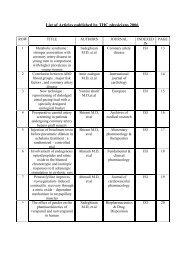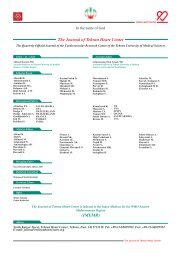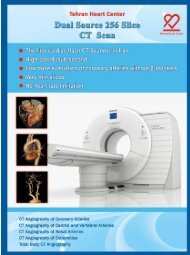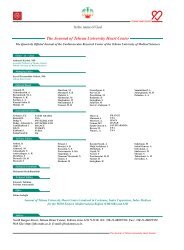Metabolic Syndrome: Stronger association With Coronary Artery
Metabolic Syndrome: Stronger association With Coronary Artery
Metabolic Syndrome: Stronger association With Coronary Artery
You also want an ePaper? Increase the reach of your titles
YUMPU automatically turns print PDFs into web optimized ePapers that Google loves.
BMC Cardiovascular Disorders<br />
BioMed Central<br />
Research article<br />
Comparison of outcomes of percutaneous coronary intervention on<br />
proximal versus non-proximal left anterior descending coronary<br />
artery, proximal left circumflex, and proximal right coronary<br />
artery: A cross-sectional study<br />
Mohammad Alidoosti* 1 , Mojtaba Salarifar 1 , Ali Mohammad Haji Zeinali 1 ,<br />
Seyed Ebrahim Kassaian 1 and Maria Raissi Dehkordi 2<br />
Open Access<br />
Address: 1 Department of Interventional Cardiology, Tehran Heart Center, Medical Sciences/University of Tehran. Jalal Al Ahmad and North<br />
Karegar Cross PO Box: 1411713138 Tehran, Iran and 2 Research Department, Tehran Heart Center, Medical Sciences/University of Tehran, Jalal Al<br />
Ahmad and North Karegar Cross. PO Box: 1411713138 Tehran, Iran<br />
Email: Mohammad Alidoosti* - salidoosti@hotmail.com; Mojtaba Salarifar - salarifar@tehranheartcenter.org; Ali<br />
Mohammad Haji Zeinali - ali_zeinali_cardio@yahoo.com; Seyed Ebrahim Kassaian - ekassaian@yahoo.com;<br />
Maria Raissi Dehkordi - mari_d81@yahoo.com<br />
* Corresponding author<br />
Published: 4 March 2007<br />
BMC Cardiovascular Disorders 2007, 7:7 doi:10.1186/1471-2261-7-7<br />
This article is available from: http://www.biomedcentral.com/1471-2261/7/7<br />
Received: 27 June 2006<br />
Accepted: 4 March 2007<br />
© 2007 Alidoosti et al; licensee BioMed Central Ltd.<br />
This is an Open Access article distributed under the terms of the Creative Commons Attribution License (http://creativecommons.org/licenses/by/2.0),<br />
which permits unrestricted use, distribution, and reproduction in any medium, provided the original work is properly cited.<br />
Abstract<br />
Background: Previous studies have shown that lesions in proximal left anterior descending coronary artery (LAD) may<br />
develop more restenosis after balloon angioplasty than lesions in other coronary segments. However, stenting seems to have<br />
reduced this gap. In this study, we compared outcomes of percutaneous coronary intervention (PCI) on proximal LAD versus<br />
proximal left circumflex (LCX) or right coronary artery (RCA) and proximal versus non-proximal LAD.<br />
Methods: From 1737 patients undergoing PCI between March 2004 and 2005, those with cardiogenic shock, primary PCI,<br />
total occlusions, and multivessel or multi-lesion PCI were excluded. Baseline characteristics and in-hospital outcomes were<br />
compared in 408 patients with PCI on proximal LAD versus 133 patients with PCI on proximal LCX/RCA (study I) and 244<br />
patients with PCI on non-proximal LAD (study II). From our study populations, 449 patients in study I and 549 patients in study<br />
II participated in complete follow-up programs, and long-term PCI outcomes were compared within these groups. The<br />
statistical methods included Chi-square or Fisher's exact test, student's t-test, stratification methods, multivariate logistic<br />
regression and Cox proportional hazards model.<br />
Results: In the proximal LAD vs. proximal LCX/RCA groups, smoking and multivessel disease were less frequent and drugeluting<br />
stents were used more often (p = 0.01, p < 0.001, and p < 0.001, respectively). Patients had longer and smaller-diameter<br />
stents (p = 0.009, p < 0.001, respectively). In the proximal vs. non-proximal LAD groups, multivessel disease was less frequent<br />
(p = 0.05). Patients had larger reference vessel diameters (p < 0.001) and were more frequently treated with stents, especially<br />
direct stenting technique (p < 0.001). Angiographic success rate was higher in the proximal LAD versus proximal LCX/RCA<br />
and non-proximal LAD groups (p = 0.004 and p = 0.05, respectively). In long-term follow-up, major adverse cardiac events<br />
showed no difference. After statistical adjustment for significant demographic, angiographic or procedural characteristics, longterm<br />
PCI outcomes were still similar in the proximal LAD versus proximal LCX/RCA and non-proximal LAD groups.<br />
Conclusion: Despite the known worse prognosis of proximal LAD lesions, in the era of stenting, our long-term outcomes<br />
were similar in patients with PCI on proximal LAD versus proximal LCX/RCA and non-proximal LAD. Furthermore, we had<br />
better angiographic success rates in patients with PCI on proximal LAD.
















